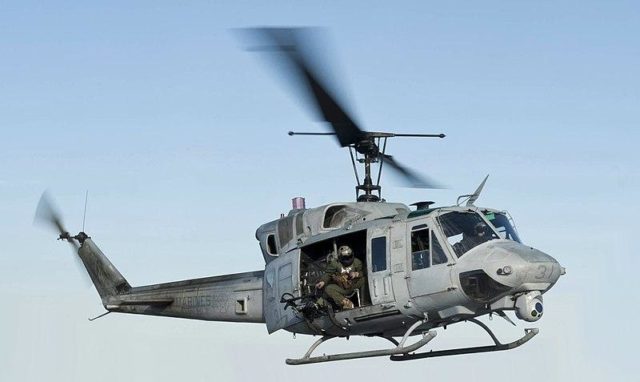
Ukraine to License-Build US Helicopters for Its Armed Forces
Publication: Eurasia Daily Monitor Volume: 18 Issue: 46
By:

Ukraine’s efforts to politically and military integrate with the West greatly intensified after Russia’s 2014 absorption of Crimea, while the subsequent and ongoing war in Donbas against combined Russian-proxy army units emphasized the need for Ukraine’s Armed Forces to reduce their dependence upon Soviet-era doctrine and weaponry much far as possible. On February 26, the Ukrainian state defense enterprise Ukroboronprom’s general director, Yuriy Husyev, announced that the government-owned Odesa Aviation Factory would begin production, under license, of the United States’ Bell UH-1 Iroquois military helicopters, with the first airframes to be delivered by August 24—the 30th anniversary of Ukraine’s independence (Interfax, February 26). The specifics of the agreement were not released.
The Odesa Aviation Plant State Enterprise is an astute choice for the first licensed Ukrainian-US defense co-production. Established in 1911, the facility is one of the oldest aviation manufacturing and overhaul plants in Europe, currently specializing in repairing MiG-21, MiG-23, MiG-27, MiG-29, L-39, An-12, An-24, An-26 and Yak-40 aircraft, modernizing MiG-21 and L-39 airframes, refurbishing various aircraft engines, producing spare parts, as well as training staff within the aerospace sector (Ukroboronprom.com.ua, February 26).
And the specific military chopper model chosen to build in Ukraine also has important advantages. From the earliest significant encounter between US troops and the North Vietnamese military in South Vietnam’s Ia Drang Valley in November 1965 to the ignominious evacuation of Saigon a decade later, the rugged, easy-to-maintain Bell UH-1 “Huey” Iroquois, the first turbine-powered helicopter to enter military service, proved itself an enormously valuable air mobility asset. Beginning its initial US deployment in 1960, the last Huey made its final flight in December 2016—its 56-year longevity attesting to the sturdiness of the airframe, similar to the US Air Force’s A-10 Thunderbolt II “Warthog”(introduced in 1977, operational for 44 years) and B-52 strategic bomber (continuously upgraded since it began service in 1955, with a 66-year service record) (Army.mil, January 12, 2017).
Financing for the initial UH-1 production in Ukraine will be provided by US companies Aviastar Invest Corp and Southwest Florida Aviation International (founded in 1982 as a partner of Bell Helicopter) as well as the Czech firm DISTAR CZ (Dumskaya.net, March 12, 2021). Manufacturing will actually begin with civilian versions of the Huey—Bell SW-205, SW-206 and SW-212 airframe designs—followed by military variants.
Because of its rich energy and mineralogical deposits, Ukraine became one of the Soviet Union’s leading republics hosting advanced military-industrial facilities. And although following the Soviet collapse in 1991 domestic orders from an independent Ukraine dwindled, many of its military-industrial enterprises retained sufficient resources to begin modest revivals years later. This moderate rebirth included the country’s aeronautical industrial base, which is now attracting growing foreign interest. The Odessa Aviation Plant State Enterprise is not Ukraine’s sole facility capable of helicopter construction. Ukrainian Deputy Prime Minister and Minister of Strategic Industries Oleh Uruskii, following his meeting in Kharkiv last month (February) with Ukroboronprom management and representatives of domestic aerospace companies, noted that Ukraine’s aeronautical industrial infrastructure had rebuilt its capacity to be able to construct dozens of aircraft annually. Uruskii added that Ukrainian aircraft manufacturers were creating a national helicopter construction sector. In particular, the Zaporizhia-based PJSC Motor Sich aeronautical engine manufacturing facility is capable of producing all of the country’s helicopter propulsion systems, the Ukrainian deputy prime minister asserted. This will finally allow Ukraine to supplant imported aviation components with domestic production (Kmu.gov.ua, February 25).
Although the majority of Motor Sich shares were surreptitiously sold off to Chinese-linked shell companies at various points in recent years, in a reversal of policy, this core element of Ukraine’s Soviet-era state-owned aviation manufacturing infrastructure has since been reevaluated by the government as a strategic asset and the foreign stock purchases have been legally arrested. The drawn-out Motor Sich sale controversy epitomizes the dichotomy between the cash-starved Ukrainian government’s desire to pass off struggling economic ventures to foreign investors for a quick infusion of capital on the one hand and rising national security concerns on the other hand. So while the Ukrainian government had invited foreign tenders to purchase the firm, leaving Chinese investors with the apparent majority of shares (see EDM, September 6, 2019; see China Brief, November 19, 2020), the authorities subsequently reconsidered the sale.
The situation reached a boiling point on January 31, 2021, when Ukraine’s State Security Service (SSU) raided a Motor Sich shareholder meeting initiated by Chinese investors and Ukrainian businessman Oleksandr Yaroslavsky. The SSU’s forceful intervention was reportedly motivated by concern that the meeting would result in a shakeup to the company’s board membership, subsequently permitting the company’s strategic assets and technologies to be transferred outside of Ukraine (Ekonomichna Pravda, February 8; see EDM, February 3, 16).
The Ukrainian government only intensified its approach since then, culminating most recently in the March 11 meeting of the National Security and Defense Council (NSDC), where it decided to formally return Motor Sich to state ownership. Underscoring the importance of the announcement, the NSDC meeting was broadcast live on the Facebook page of the Ukrainian Presidential Office. Defense Council Secretary Alexei Danilov simply remarked, “Today, a decision was made. According to this decision, Motor Sich will be returned to the Ukrainian people—will be returned to the ownership of the Ukrainian state in a legal, constitutional manner in the near future” (UNIAN, March 11).
Helicopters represent a prime example of “dual use” technology, so the introduction of US civilian/military models into a neighboring post-Soviet state with a heavy industrial sector and financed with foreign capital can only produce unease in the Kremlin. Meanwhile, the Ukrainian-Russian war slogs into its eighth year and is showing signs of possibly intensifying sharply in the coming weeks (see EDM, March 11, 15). As such, Ukraine’s need to more quickly bolster its military capabilities will surely increase—and so may the number of military-industrial deals with Western partners akin to the recent Huey production agreement.



